How to Dehydrate Strawberries
This post may contain affiliate links.
Dehydrated strawberries are incredibly easy to make and are a great way to capture the freshness of this early summer berry. Dried strawberries are easy to make, and in this post we cover everything, step-by-step!
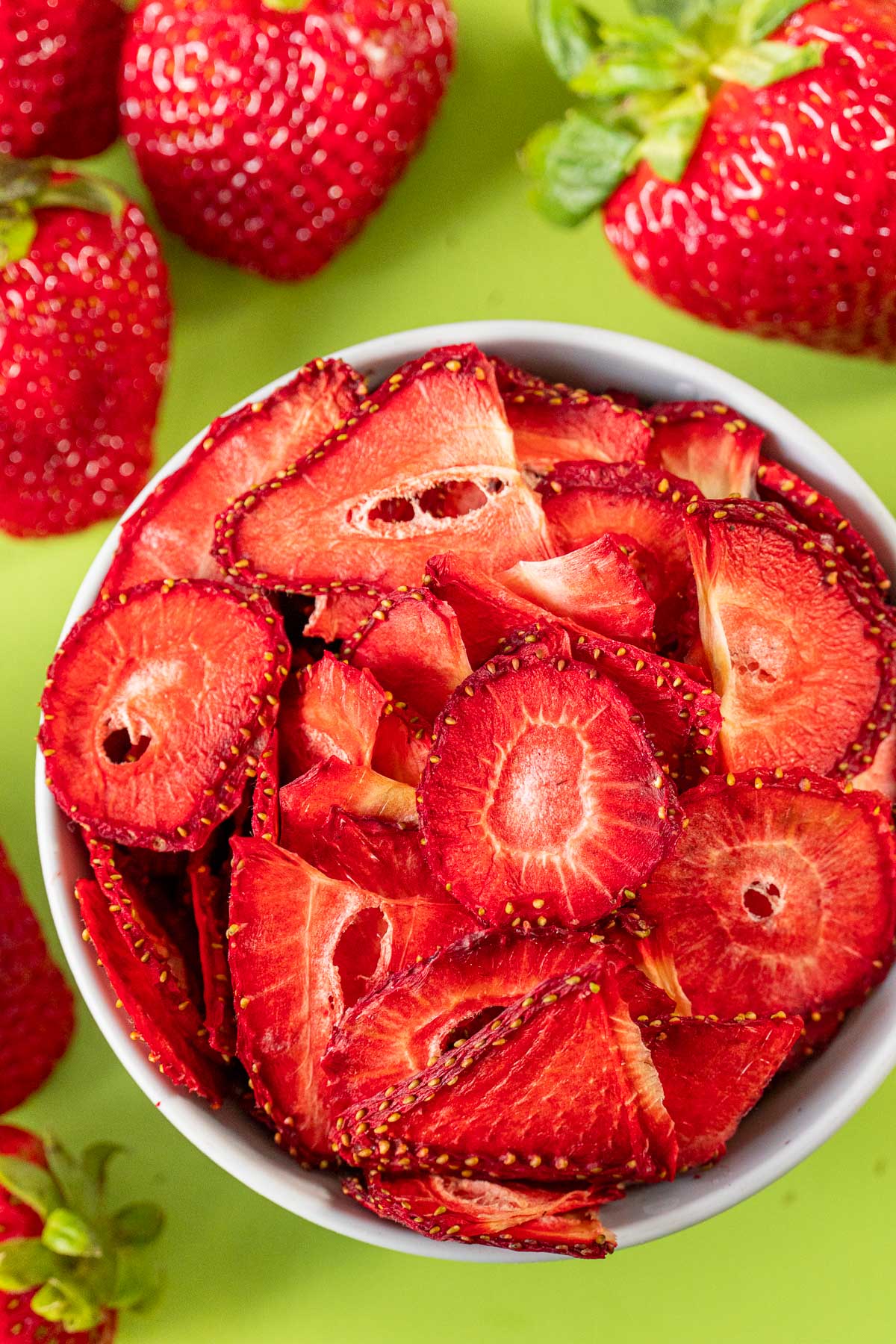
We love making dried strawberries! They have a sunny sweetness that always reminds us of the start of summer. Not only are they great for snacking on as dried chips, but they can be used for a lot of different culinary applications.
Dehydrated strawberries can be used to top oatmeal, cereal, or yogurt. They can be baked into scones or muffins. When rehydrated with some boiling water and sugar, they make a wonderful compote that can be served on top of pancakes or with granola as a strawberry crumble dessert. There are lots of options!
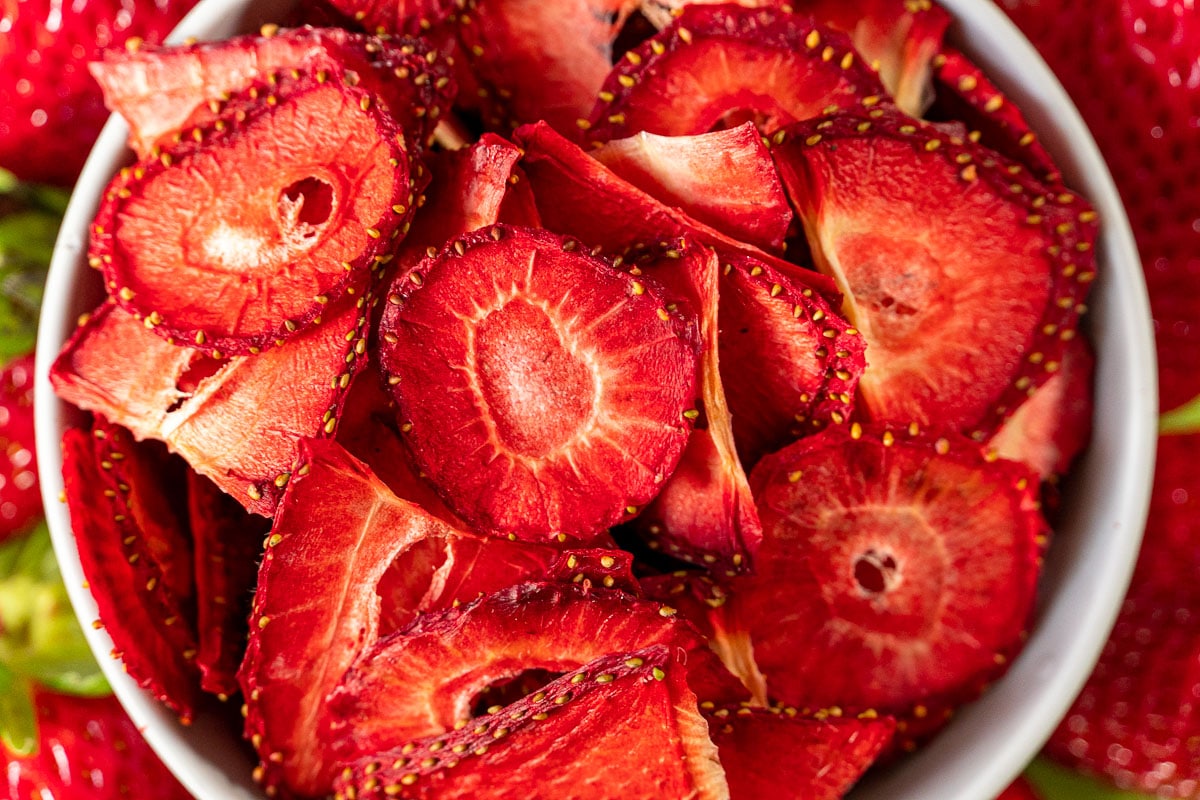
Thanks to international imports, strawberries can be found at any major grocery store year-round. However, the peak season for domestic strawberries is the month of June (give or take a month depending on climate.) This is when your local farmer’s market will be overflowing with cartons of vibrantly red, sun-ripened strawberries. These couple of weeks are not to be missed!
But one of the best ways to preserve that eve-of-summer flavor is to dehydrate your strawberries!
So if you’re looking to extend your strawberries throughout the summer (and well beyond!), then we’ve got you covered! Below we share everything you need to know to start dehydrating strawberries.
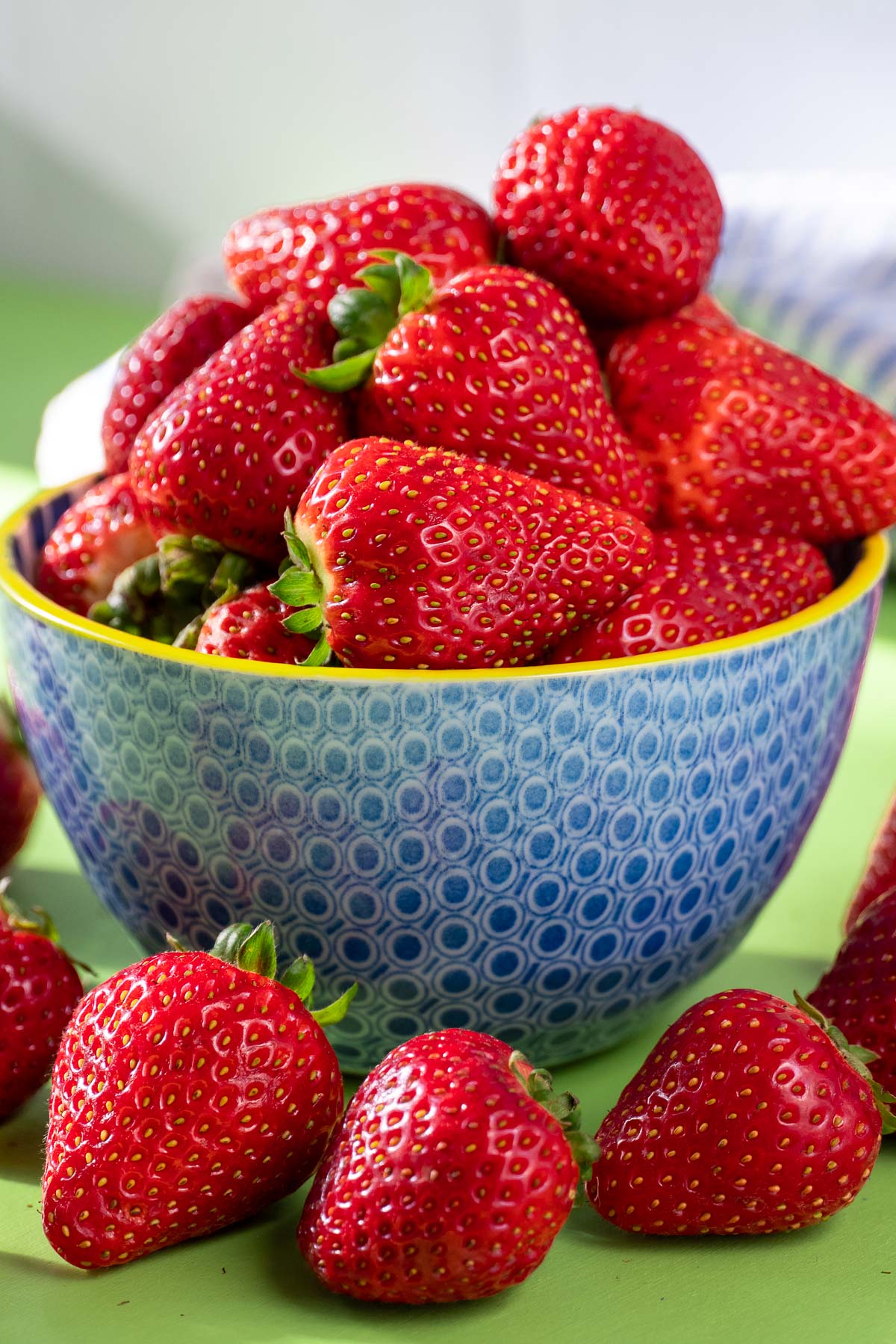
Choosing strawberries to dehydrate
To get the best results, choose fully ripe, plump, bright red strawberries. Set aside any that are bruised, have dark spots, or are showing signs of mold. Strawberries with a lot of white on their tops aren’t quite ripe and can result in sour or tart flavors.
Choose organic strawberries if possible, as strawberries are on the top of the “dirty dozen” list, meaning they are more likely to contain pesticide residues.
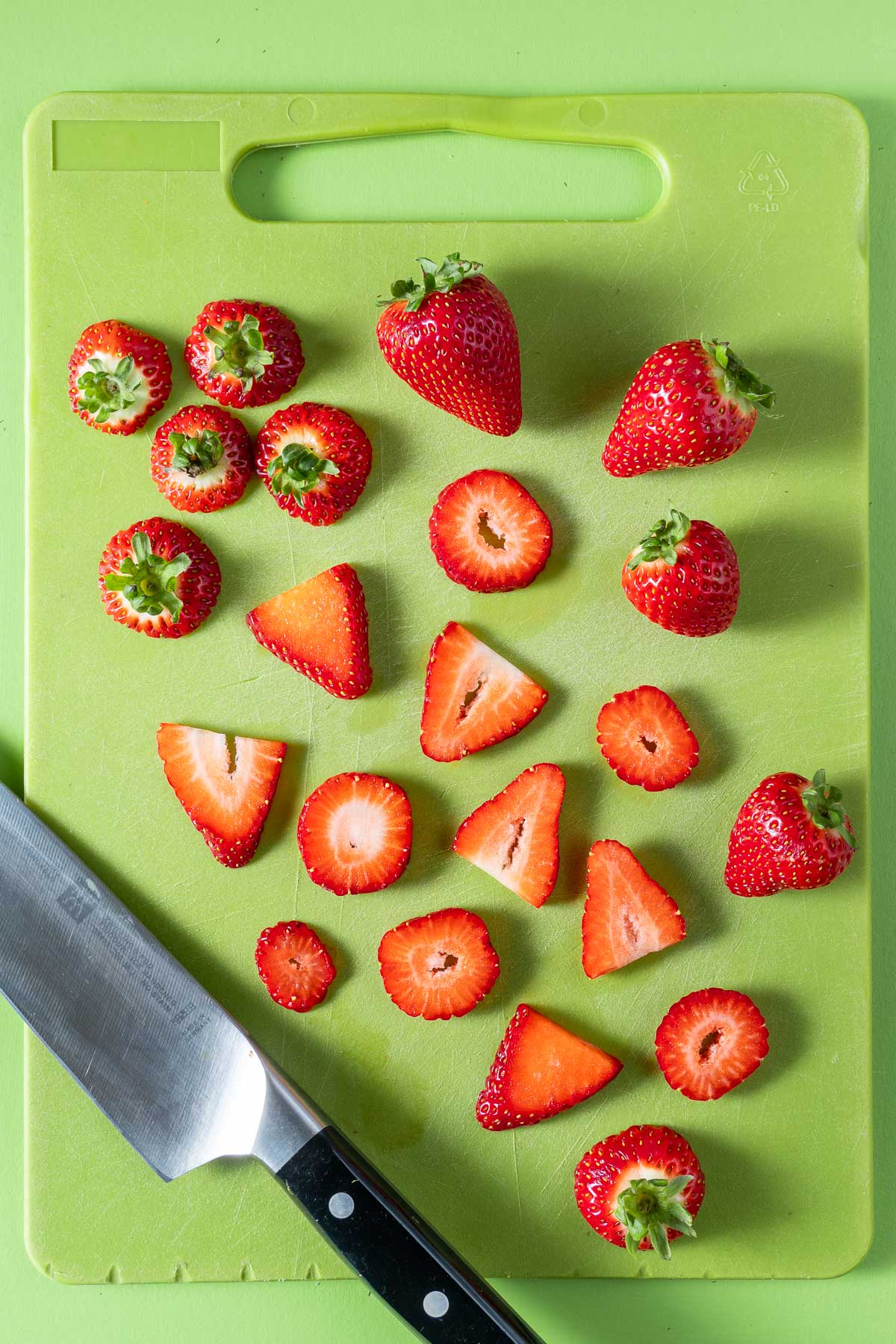
Prepping strawberries for dehydrating
Before you start prepping your strawberries, make sure your counters, equipment, and hands are clean & sanitized to prevent contamination, which can spoil your batch down the line.
- Clean the strawberries: Thoroughly wash the strawberries and gently dry with a clean towel. Set aside any that are bruised or beining to mold.
- Remove the stems and leaves. If you have one, you can use a strawberry huller to remove the middle, but it’s not necessary.
- Slice the strawberries: Using a sharp knife, slice the strawberries ¼”-⅜” thick. You can slice them cross-wise or pole to pole—either way works fine. Try to keep the pieces to a uniform size to help with even drying.
Equipment Spotlight: Dehydrators
If you’re in the market for a dehydrator, we recommend buying one with an adjustable temperature. This will allow you to dial in the drying temp to give you the best results for individual ingredients. The dehydrator we recommend (and use) most often is the COSORI dehydrator. You can also check out our best dehydrators post for a comparison of all the dehydrators we’ve used and would recommend.
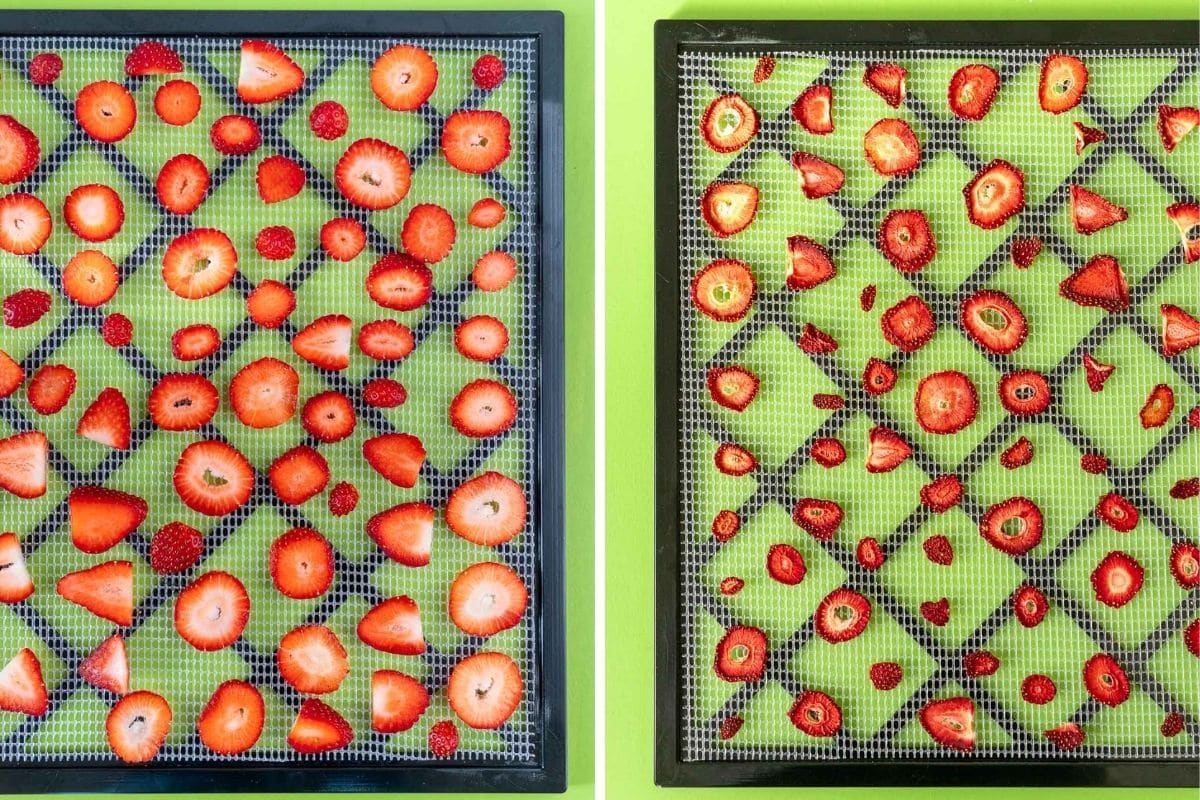
How to dehydrate strawberries
Dehydrating strawberries is fairly simple and straightforward—a great ingredient for beginners! Once your strawberries are prepped, set up your dehydrator and follow these steps:
- Arrange the strawberries on your dehydrator trays. If you’re using a tray that has large holes, line it with parchment paper or, better yet, a mesh liner cut to the size of your tray. Leave space between the pieces to allow air to circulate.
- Dehydrate at 135ºF (57ºC) for 6-12 hours until the strawberries are dry and leathery or crisp.
- Depending on your machine, you may need to rotate the trays every so often to promote even drying.
- Dehydrating strawberries in the oven: Place the strawberries in a single layer baking sheet lined with a silicone mat (this will prevent sticking). Dry in the oven on its lowest temperature setting—if possible, keep the door propped open to allow steam to escape (be careful if you have children or pets!). Flip the pieces over every hour and remove as soon as they are completely dry.
How to tell when strawberries are done
Strawberries should be pliable when they are completely dried but have no obvious remaining moisture (tear one in half and squeeze—if moisture appears, dry them longer). If you sliced your strawberries thin for crunchier chips, you can dehydrate them until they snap when bent. Take a few pieces off and let them cool before testing.
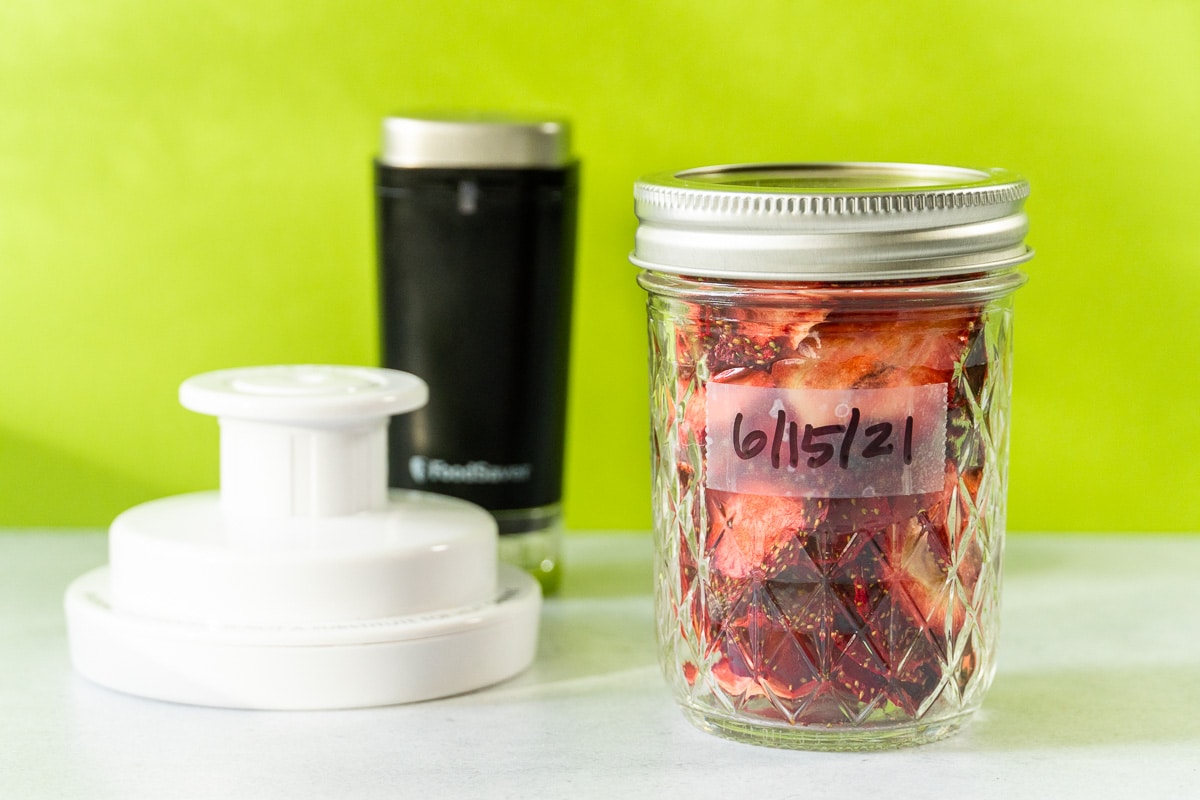
How to store
If you’re dehydrating strawberries for snacking and plan on eating them within a week or two, you can store them in a sealed container or zip-top bag on the counter or in your pantry. Be sure to let them cool first before placing them in the container. We like to use these reusable ReZip bags.
However, if properly dried and stored, dehydrated strawberries can last up to a year! Here are our tips for long term storage:
- Cool: Let the strawberries cool completely before transferring them.
- Condition: Loosely pack the strawberries in a transparent airtight container. Check it daily for a week to check for signs of moisture or condensation, and shake to help prevent the strawberries slices from sticking together. If signs of moisture appear, stick them back into the dehydrator (as long as there’s no mold—in that case, toss the batch). After a week, if there’s no signs of moisture or mold, you can package them for long-term storage.
- Store in a clean, airtight container. For longer shelf life, vacuum seal.
- Use a moisture absorbing desiccant packet if you anticipate opening the container often, or if you live in an area with high humidity.
- Label the container with the date and any other important details
- Place the container in a cool, dark, and dry place—inside of a pantry cabinet works well.
Vacuum Sealing Tips
We like to store our dehydrated food in mason jars that have been vacuum-sealed using this handheld FoodSaver vacuum sealer along with these jar sealing attachments. This gives us the benefit of vacuum sealing without the waste (and expense) of plastic vacuum sealing bags. Since the jars are clear we make sure we store them in a dark spot in our pantry to keep them out of direct light.
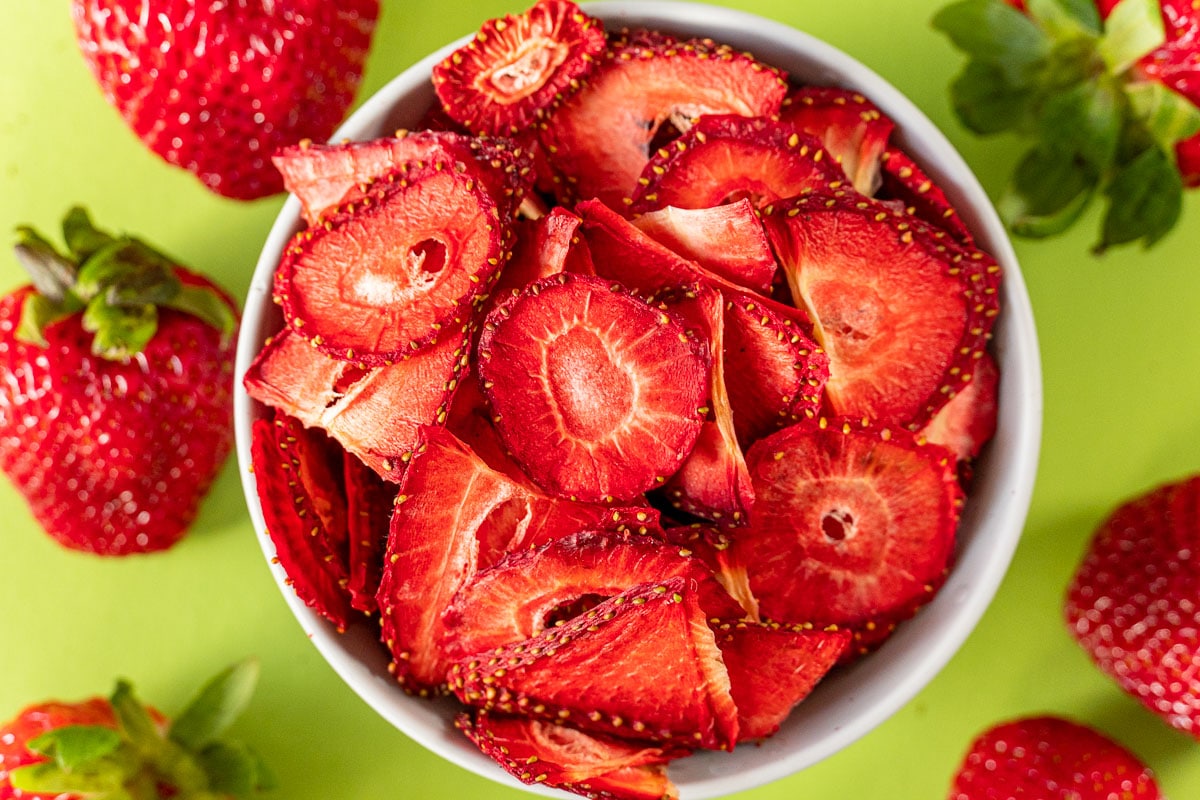
How to use
Dehydrated strawberries can be eaten right from the bag as a snack! Or, to rehydrate dried strawberries, cover them in boiling water for 15-20 minutes.
Here are a few ways to use your strawberries:
- Add to granola or oatmeal
- Use dried or rehydrated strawberries to top a yogurt parfait
- Include it in a DIY trail mix
- Rehydrate and simmer with some sugar to create a jammy compote for pancakes, waffles, oatmeal, or ice cream
- Turn them into powder to add to yogurt, cake or cupcake batter, ice cream, smoothies, cream cheese, and more!
- Use them in these backpacking/camping meals:
Fresh to dehydrated conversion
Dehydrating strawberries will reduce their weight to about 10% of their original weight. One pound of fresh strawberries will yield about 1.5 oz (42g) of dried strawberries.

Dehydrated Strawberries
Ingredients
Equipment
Instructions
- Start with clean hands, equipment, and countertops.
- Wash the strawberries and remove the tops with a knife or strawberry huller.
- Slice the strawberries into ¼"-⅜" thick slices (either cross-wise or pole-to-pole).
- Arrange strawberry slices in a single layer on dehydrator trays, ensuring there is space between pieces to allow airflow.
- Dehydrate at 135F/57C for 6-12 hours, until dry (see note 2).
Storage Tips
- Let the dried strawberries cool completely before storing.
- Short term storage: If strawberries will be consumed within a few weeks, store in a ziptop bag or sealed container on the counter or in a pantry.
- Long-term storage: Condition by loosely packing the dried strawberries in a transparent, airtight container. Leave it on the counter for a week and check it daily for signs of moisture. If condensation appears, return the strawberries to the dehydrator (unless there are signs of mold—then, throw out the whole batch). Shake occasionally to keep the pieces from sticking together.
- After conditioning, store in an airtight container in a cool, dark place for up to a year. Vacuum sealing will help extend the shelf life and quality of the strawberries.
